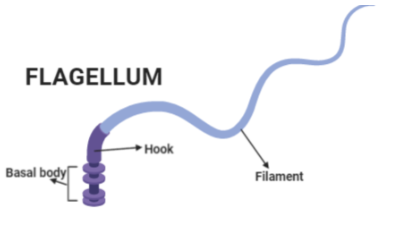Answer
414.9k+ views
Hint: There are different types of flagella. For example, stichonematic flagella is present in euglena and they have only one-row mastigonemes.
Step by step answer:
Flagella are the microscopic hair-like structures that are involved in the locomotion of a cell. The flagella have whip-like appearances that help a cell to move through the liquid. Some special flagella are used in a few organisms as sensory organs which can sense changes in pH and temperature of the surroundings. Flagella have the small hair-like structures which are called mastigonemes. There are different types of flagella.
-If the flagella have mastigonemes on only one side or row, then they are called stichonematic flagella. Such a type of flagella is found in euglena.
-If flagella have two rows of mastigonemes, then they are called pantonematic flagella.
-If there are no mastigonemes present in flagella, then they are called acronematic flagella. This type of flagella is found in Chlamydomonas.
-If there are no mastigonemes and the distal ends of the flagella end as a naked, axial filament, then they are called anemic. Such a type of flagella is found in cryptomonas.
So, the correct option is option A
Note: The flagella possess a helical structure composed of a protein called flagellin. The flagella structure comprises three parts: basal body, hook, and filament. Each has its own function.

Step by step answer:
Flagella are the microscopic hair-like structures that are involved in the locomotion of a cell. The flagella have whip-like appearances that help a cell to move through the liquid. Some special flagella are used in a few organisms as sensory organs which can sense changes in pH and temperature of the surroundings. Flagella have the small hair-like structures which are called mastigonemes. There are different types of flagella.
-If the flagella have mastigonemes on only one side or row, then they are called stichonematic flagella. Such a type of flagella is found in euglena.
-If flagella have two rows of mastigonemes, then they are called pantonematic flagella.
-If there are no mastigonemes present in flagella, then they are called acronematic flagella. This type of flagella is found in Chlamydomonas.
-If there are no mastigonemes and the distal ends of the flagella end as a naked, axial filament, then they are called anemic. Such a type of flagella is found in cryptomonas.
So, the correct option is option A
| Set-I | Set-II |
| A) Stichonematic | III) Flagellum bears one row of lateral appendages |
| B) Pantonematic | I) Flagellum has two or more rows of lateral appendages |
| C) Acronematic | IV) Flagellum does not lateral appendages and the terminal part of the acroneme is naked |
| D) Anematic | II) Flagellum has no lateral appendages and terminal filament |
Note: The flagella possess a helical structure composed of a protein called flagellin. The flagella structure comprises three parts: basal body, hook, and filament. Each has its own function.

Recently Updated Pages
How many sigma and pi bonds are present in HCequiv class 11 chemistry CBSE

Why Are Noble Gases NonReactive class 11 chemistry CBSE

Let X and Y be the sets of all positive divisors of class 11 maths CBSE

Let x and y be 2 real numbers which satisfy the equations class 11 maths CBSE

Let x 4log 2sqrt 9k 1 + 7 and y dfrac132log 2sqrt5 class 11 maths CBSE

Let x22ax+b20 and x22bx+a20 be two equations Then the class 11 maths CBSE

Trending doubts
Fill the blanks with the suitable prepositions 1 The class 9 english CBSE

At which age domestication of animals started A Neolithic class 11 social science CBSE

Which are the Top 10 Largest Countries of the World?

Give 10 examples for herbs , shrubs , climbers , creepers

Difference between Prokaryotic cell and Eukaryotic class 11 biology CBSE

Difference Between Plant Cell and Animal Cell

Write a letter to the principal requesting him to grant class 10 english CBSE

Change the following sentences into negative and interrogative class 10 english CBSE

Fill in the blanks A 1 lakh ten thousand B 1 million class 9 maths CBSE



